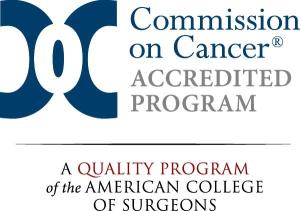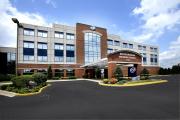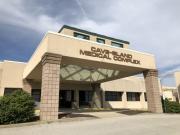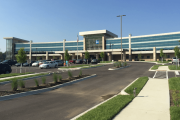Bone Cancer
If you suspect that you or a loved one have bone cancer, you’re likely already feeling overwhelmed. That’s where we come in. Our skilled and caring team is ready to work with you — and together across all fields of medicine — to develop a treatment plan tailored to your specific type of bone cancer, unique diagnosis, personal preferences and treatment goals.

As an accredited Comprehensive Community Cancer Program, we offer nearly all the same options and technology you’d find at an academic medical center, just close to home. We also treat your bone cancer holistically, caring not just for your physical health, but your mental and emotional health, too.
What is Bone Cancer?
Bone cancer develops when cells in the bone grow out of control. Bones contain two kinds of cells: osteoblasts, which are cells that form new bone, and osteoclasts, which are cells that dissolve old bone.
Cancer that starts in the cells of the bone, called primary bone cancer, is very rare. In fact, according to the American Cancer Society, it accounts for less than 1% of all cancers. Most cancer that starts in the bone spreads there from other parts of the body and is known as secondary bone cancer. Cancers that commonly spread to the bone include breast cancer, prostate cancer and lung cancer.
Bones Cancer Types
Primary bone cancers that start in the bone are also known as bone sarcomas. There are several types of bone sarcomas, including:
- Chondrosarcoma is the second most common primary bone cancer and begins in the early forms of cartilage cells. Risk for developing chondrosarcoma increases with age, so the disease rarely affects people younger than 20.
- Chordoma, which occurs most often in people over age 30, is a rare type of primary bone cancer that develops in the bones of the spine. Chordoma is also twice as common in men than in women.
- Ewing sarcoma is the second most common type of primary bone cancer in children, teens and young adults, and the third most common type of bone cancer overall. These tumors most often develop in people who are white, and rarely develop in African Americans and Asian Americans.
- Fibrosarcoma of the bone, which most often occurs in middle-aged adults, develops in the bone, generally affecting the legs, arms and jaw.
- Giant cell tumor of the bone, which is a type of primary bone cancer that most often develops in young adults, can either be cancerous or benign (noncancerous) — but is most commonly benign.
- High-grade undifferentiated pleomorphic sarcoma (UPS) of the bone was previously known as malignant fibrous histiocytoma (MFH) of bone. Although it’s rare in bones, it most often affects the legs or arms when it does occur. UPS typically affects middle-aged and older adults.
- Osteosarcoma, which is the most common primary bone cancer, starts in the early form of bone cells and typically begins in the arms, legs or pelvis. Osteosarcoma most often develops in people who are between the ages of 10 and 30.
Other types of cancer, like those that develop in bone marrow, aren’t considered primary bone cancers. These include multiple myeloma, leukemia and non-Hodgkin lymphoma. Although these cancers aren’t primary bone cancers, they’re often first found in the bones.
Bone Cancer Risk Factors
A risk factor is something that raises your risk for developing a certain type of cancer. Some, like those related to genetics, you can’t change. But others, like risk factors related to lifestyle, you can.
Many primary bone cancers aren’t linked to a known risk factor, but there are a few things that can raise your risk of developing certain types, including:
- Age, which can increase your risk of developing chondrosarcoma.
- Family history, which may play a role in the risk for chordoma.
- Paget’s disease of the bone, which is a disease that disrupts the replacement of old bone tissue with new bone tissue and can make bones more likely to break, making you slightly more susceptible to developing a bone tumor.
- Radiation therapy, which can slightly increase your risk of developing bone cancer in the area that was treated.
Bone Cancer Symptoms
Symptoms of bone cancer typically depend on the type of the cancer, its location and whether it’s spread, but can include:
- A lump or swelling in the bone
- Fatigue
- Fractures in the bones
- Numbness and tingling
- Pain in a certain part of the bone
- Weight loss
Diagnosing Bone Cancer
To diagnose bone cancer, we’ll most often start with a physical exam. Then, we’ll likely order other tests, such as:
- Biopsy
- Blood tests
- Bone scan
- CT scan
- MRI
- PET-CT scan
- X-ray
Treating Bone Cancer
Your cancer care team will work with you to develop a treatment plan that aligns with your individual preferences and goals. Your team may include a medical oncologist, radiation oncologist, surgical oncologist and orthopedic specialist, but you may also consult with others during treatment, such as dietitians, counselors and nurse practitioners.
The main treatment for bone cancer — particularly bone cancer that hasn’t spread — is surgery. We may remove a tumor and a margin of healthy bone or tissue around the tumor at the same time as we perform a biopsy. For bone cancers that have spread, we’re more likely to use a combination of treatments, such as surgery and chemotherapy.
For most types of primary bone cancer, cancer cells aren’t easily killed by radiation, so high doses are needed. For this reason, radiation therapy isn’t used as the main treatment for most types of bone cancer. When radiation is recommended, it’s typically one of the following types:
- Intensity-modulated radiation therapy (IMRT) uses a computer program to shape and aim radiation beams at the tumor from several angles, as well as adjust the intensity of the beams. This helps reduce radiation damage to nearby tissue.
- Proton-beam radiation therapy uses protons to kill cancer cells, rather than X-rays or other types of radiation.
- Stereotactic radiosurgery (SRS) delivers a large dose of radiation to a small area, usually in just one session.
We also use chemotherapy to treat certain types of bone cancer, including Ewing sarcoma, osteosarcoma and UPS, for example.
In some cases, we may also use immunotherapy and targeted therapy drugs. Targeted therapy drugs known as kinase inhibitors are especially helpful in treating chordomas and other types of bone cancer that don’t respond well to chemotherapy, as well as some advanced chondrosarcomas.






























